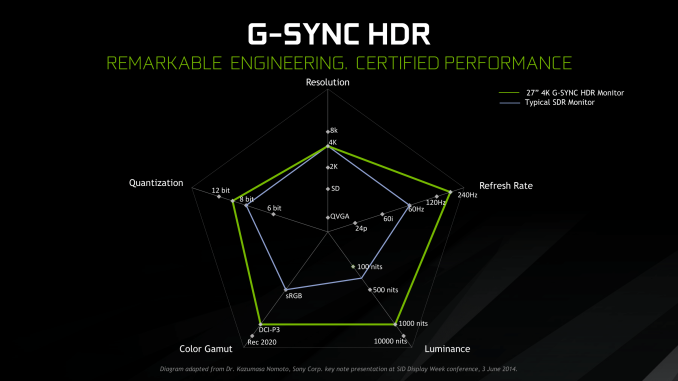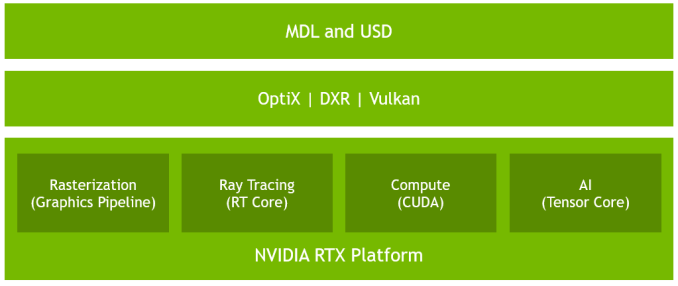The NVIDIA GeForce RTX 2080 Ti & RTX 2080 Founders Edition Review: Foundations For A Ray Traced Future
by Nate Oh on September 19, 2018 5:15 PM EST- Posted in
- GPUs
- Raytrace
- GeForce
- NVIDIA
- DirectX Raytracing
- Turing
- GeForce RTX
Meet The New Future of Gaming: Different Than The Old One
Up until last month, NVIDIA had been pushing a different, more conventional future for gaming and video cards, perhaps best exemplified by their recent launch of 27-in 4K G-Sync HDR monitors, courtesy of Asus and Acer. The specifications and display represented – and still represents – the aspired capabilities of PC gaming graphics: 4K resolution, 144 Hz refresh rate with G-Sync variable refresh, and high-quality HDR. The future was maxing out graphics settings on a game with high visual fidelity, enabling HDR, and rendering at 4K with triple-digit average framerate on a large screen. That target was not achievable by current performance, at least, certainly not by single-GPU cards. In the past, multi-GPU configurations were a stronger option provided that stuttering was not an issue, but recent years have seen both AMD and NVIDIA take a step back from CrossFireX and SLI, respectively.
Particularly with HDR, NVIDIA expressed a qualitative rather than quantitative enhancement in the gaming experience. Faster framerates and higher resolutions were more known quantities, easily demoed and with more intuitive benefits – though in the past there was the perception of 30fps as cinematic, and currently 1080p still remains stubbornly popular – where higher resolution means more possibility for details, higher even framerates meant smoother gameplay and video. Variable refresh rate technology soon followed, resolving the screen-tearing/V-Sync input lag dilemma, though again it took time to catch on to where it is now – nigh mandatory for a higher-end gaming monitor.
For gaming displays, HDR was substantively different than adding graphical details or allowing smoother gameplay and playback, because it meant a new dimension of ‘more possible colors’ and ‘brighter whites and darker blacks’ to gaming. Because HDR capability required support from the entire graphical chain, as well as high-quality HDR monitor and content to fully take advantage, it was harder to showcase. Added to the other aspects of high-end gaming graphics and pending the further development of VR, this was the future on the horizon for GPUs.
But today NVIDIA is switching gears, going to the fundamental way computer graphics are modelled in games today. Of the more realistic rendering processes, light can be emulated as rays that emit from their respective sources, but computing even a subset of the number of rays and their interactions (reflection, refraction, etc.) in a bounded space is so intensive that real time rendering was impossible. But to get the performance needed to render in real time, rasterization essentially boils down 3D objects as 2D representations to simplify the computations, significantly faking the behavior of light.
It’s on real time ray tracing that NVIDIA is staking its claim with GeForce RTX and Turing’s RT Cores. Covered more in-depth in our architecture article, NVIDIA’s real time ray tracing implementation takes all the shortcuts it can get, incorporating select real time ray tracing effects with significant denoising but keeping rasterization for everything else. Unfortunately, this hybrid rendering isn’t orthogonal to the previous concepts. Now, the ultimate experience would be hybrid rendered 4K with HDR support at high, steady, and variable framerates, though GPUs didn’t have enough performance to get to that point under traditional rasterization.
There’s a still a performance cost incurred with real time ray tracing effects, except right now only NVIDIA and developers have a clear idea of what it is. What we can say is that utilizing real time ray tracing effects in games may require sacrificing some or all three of high resolution, ultra high framerates, and HDR. HDR is limited by game support more than anything else. But the first two have arguably minimum performance standards when it comes to modern high-end gaming on PC – anything under 1080p is completely unpalatable, and anything under 30fps or more realistically 45 to 60fps hurts the playability. Variable refresh rate can mitigate the latter and framedrops are temporary, but low resolution is forever.
Ultimately, the real time ray tracing support needs to be implemented by developers via a supporting API like DXR – and many have been working hard on doing so – but currently there is no public timeline of application support for real time ray tracing, Tensor Core accelerated AI features, and Turing advanced shading. The list of games with support for Turing features - collectively called the RTX platform - will be available and updated on NVIDIA's site.













337 Comments
View All Comments
imaheadcase - Wednesday, September 19, 2018 - link
They wouldn't, because they would not have the extra bloat in the card, but performed the exact same..people would get the AMD card because of all the bullshit in the nvidia card not yet even proven to by worth it.Better question: How much does nvidia pay you to be a shill here and on forums? I mean you are obviously delusional about it.
DigitalFreak - Wednesday, September 19, 2018 - link
Typical fanboy response.Fritzkier - Wednesday, September 19, 2018 - link
Do you actually read V900's other comments? He is a shill.And anyway AMD did the same thing with Vega 64 (1080 ish performance but a little expensive, except in Vulkan) and see that many also outrageous with Vega releases. That's just because AMD is one year late and making it a little expensive.
bji - Wednesday, September 19, 2018 - link
He may not be a shill; perhaps he's just trying to counterbalance the clueless posters who don't understand why products cost what they do.I know that I am not a shill for anyone, but I can understand the motivation in posting something like that.
tamalero - Wednesday, September 19, 2018 - link
Cost means nothing if they cant provide what they are expected to.Noone gives a darn if the die is insane if their performance isnt as good as promised.
R600 was huge, hot, and was a total new game in graphic design and tech. Was its performance good? NO.
Inteli - Wednesday, September 19, 2018 - link
I think they're substantially overblowing the significance of raytracing and DLSS, at least in this generation's lifespan.The best way I've seen it put is this: look at the Shadow of the Tomb Raider demo. There isn't *that* much of a difference between raytracing on and off. Shaders, ambient occlusion, and other such cheats have gotten so good that they're very close to ray tracing.
Will ray tracing ever be significantly better than raster rendering? Of course it will. It's the future of rendering. Is it significantly better now? No.
It's not an issue of "card is expensive", it "card isn't a good value compared to its predecessors in current games". Most of those extra transistors aren't contributing to the card's performance right now, so you're paying a lot more for nothing, at least right now. For current games, the 2080 is 1080 Ti performance for 1080 Ti prices.
Unless you either A. must have the latest and greatest, or B. anticipate playing games that have been confirmed to support RT, I don't see a compelling reason to buy a 2080 over a 1080 Ti, at least until 1080 Ti supply dries up.
BurntMyBacon - Thursday, September 20, 2018 - link
@Inteli: "For current games, the 2080 is 1080 Ti performance for 1080 Ti prices."I think you meant greater than 1080Ti prices. At the same price and performance, I'd buy newer if for no other reason than to have longer support. The extra features (regardless of whether or not they are used in games I play) are just icing on the cake at that point.
Inteli - Saturday, September 22, 2018 - link
Right.eva02langley - Thursday, September 20, 2018 - link
Because it is their only selling point. It is obviously not the performances.imaheadcase - Wednesday, September 19, 2018 - link
OH so my 1080Ti makes me a AMD fanboy. right..